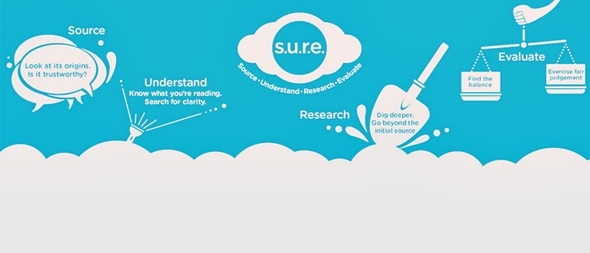.
“Eating Kangkong can give you weak legs.”
“McDonald’s burger won’t rot.”
“Fat-free or low-fat diet would help people lose weight.”
“Can warm milk help you sleep?”
S.U.R.E. or not?
Unknowingly, many of us are drowning in hearsay and old wives’ tales without digging deeper to verify facts. I really thought eating Kangkong (water spinach) regularly could cause our legs feel like jelly! Naturally, the more things get repeated, the more people will believe them.
Recently, National Library Board (NLB) launched the S.U.R.E. campaign to promote the importance of information literacy. With more people from different age groups spending longer hours sifting through the Internet in the current media landscape, the campaign surely comes in timely by getting the general public to start thinking about whether the information we receive in our daily lives, especially on social media, is credible.
S.U.R.E. aims to equip people with a 4-step process to verify if the information they read online is a rumour, half-truth or true:
Source: Where does the original information come from? Is it trustworthy?
Understand: Search for clarity and look for facts.
Research: Dig deeper and investigate carefully beyond the initial source. Check and compare.
Evaluate: It’s all a matter of perspective – there is always two sides to a story. Seek a fair balance.

It’s easy to say ‘Sharing is Caring’. Browse throughout the news feed and updates on social media sites like Facebook and we see loads of articles shared on networks. Honestly, did we really read them thoroughly or simply click ‘like’ and spread the information around quickly?
Oh yes, we love interesting stories – sensationalized news. And I have been GUILTY myself for sharing articles and videos that are half-truth or exaggerated on Facebook.

As a travel blogger who has been sharing itineraries on this blog and social media sites, I find that the S.U.R.E campaign gives an important set of research guidelines to follow. It takes up quite a significant amount of time to research on the destinations while planning an itinerary before publishing it online.
Personally, I believe in “value-added” articles that are helpful to the readers. While information is sparsely available on the Internet, it is useful to know the last update of the information and the intention of those websites – whether they are simply replicating the contents of other websites and publish unverified articles for the sake of generating online traffic in a short period of time; or they are promoting the product with biased information.
While researching on the destination for sightseeing, transport, accommodation and places to eat, I would compare the information with multiple sources, including official tourism board websites and review sites like TripAdvisor. Not forgetting to ask for recommendations from friends who have been to there before; and check out the air fares and hotel room rates from professionals in the travel industry while comparing the deals with online booking sites.
As the saying goes, a journey is worth more than a thousand words. To dig beyond what can be found online, I would collect up-to-date information and talk to the locals to gain insights of the place while travelling. When it comes to blogging, I would read up the history, backgrounds and related articles to get a bigger picture of what I learn on the trip. Mostly, I would only blog about the places after I have been there myself, so that I am not only sharing information but personal experiences and tips. After all, TravelerFolio is my online journal where I reminisce about my travels.
Last but not least, everyone has different travel styles and goals. Just like people have different taste buds. Be it a popular attraction or restaurant, don’t just follow the crowd. Decide what you really want to see and do on the trip.
For more tips on how to tell fact from fiction, visit the S.U.R.E. Facebook Page

Leave a Reply